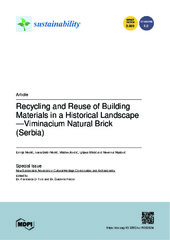Приказ основних података о документу
Recycling and Reuse of Building Materials in a Historical Landscape—Viminacium Natural Brick (Serbia)
| dc.creator | Nikolić, Emilija | |
| dc.creator | Delić-Nikolić, Ivana | |
| dc.creator | Jovičić, Mladen | |
| dc.creator | Miličić, Ljiljana | |
| dc.creator | Mijatović, Nevenka | |
| dc.date.accessioned | 2023-03-09T09:33:04Z | |
| dc.date.available | 2023-03-09T09:33:04Z | |
| dc.date.issued | 2023 | |
| dc.identifier.issn | 2071-1050 | |
| dc.identifier.uri | http://rai.ai.ac.rs/handle/123456789/495 | |
| dc.description.abstract | During the MoDeCo2000 scientific and research project on mortars used in the territory of the Roman Danube Limes in Serbia, the biggest challenge was the quest for the provenance of raw materials. The area where Viminacium, the largest city in the province of Moesia Superior developed, with millennial continuity of land use and settlement, was selected as research case study and is presented in this research. People throughout history have always used what they had at hand, and the building remains were not only reused but also recycled for new constructions. Thus, the building material of Roman Viminacium has survived in the landscape through the in situ preserved remains of Roman buildings, as well as in the structures from the later periods, up to today. To the best of our knowledge, the use of natural sediments baked during the self-combustion or combustion of underneath layers (coal in our case) for the purpose of construction was extremely rare in the Roman Empire. In this study, we follow the presence of this type of material precisely in Viminacium construction, naming it natural brick, while focusing on its potential use in lime mortars whose production was perfected in the Roman period and has never been surpassed afterward. Archaeological contexts in which this material was found have been studied, along with simultaneous work in the laboratory and in the field during the research and experimental use of the natural brick in lime mortars. We sought to determine whether this material could have been recognised by Romans in Viminacium as a potential valuable pozzolanic component of mortar, along with or instead of fired brick, being locally available and recyclable. The final confirmation of its pozzolanic features and later discussion open completely new directions for the future research of Viminacium lime mortars. | sr |
| dc.language.iso | en | sr |
| dc.publisher | MDPI | sr |
| dc.relation | info:eu-repo/grantAgreement/ScienceFundRS/Promis/6067004/RS// | sr |
| dc.rights | openAccess | sr |
| dc.rights.uri | https://creativecommons.org/licenses/by/4.0/ | |
| dc.source | Sustainability | sr |
| dc.subject | Viminacium | sr |
| dc.subject | natural brick | sr |
| dc.subject | Roman mortar | sr |
| dc.subject | pozzolan | sr |
| dc.subject | natural clinker | sr |
| dc.subject | coal combustion | sr |
| dc.subject | building material | sr |
| dc.subject | recycling | sr |
| dc.subject | reuse | sr |
| dc.subject | sustainability | sr |
| dc.title | Recycling and Reuse of Building Materials in a Historical Landscape—Viminacium Natural Brick (Serbia) | sr |
| dc.type | article | sr |
| dc.rights.license | BY | sr |
| dc.rights.holder | sr | |
| dc.citation.issue | 3 | |
| dc.citation.spage | 2824 | |
| dc.citation.volume | 15 | |
| dc.identifier.doi | https://doi.org/10.3390/su15032824 | |
| dc.identifier.fulltext | http://rai.ai.ac.rs/bitstream/id/1264/sustainability-15-02824-with-cover.pdf | |
| dc.type.version | publishedVersion | sr |


